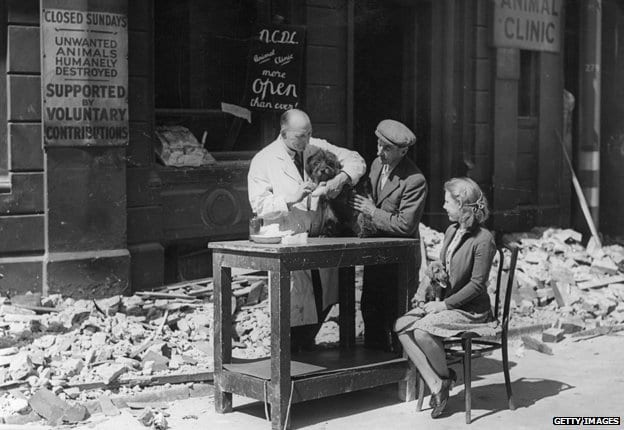Britain: The Great Pet Massacre

This dog was treated by a vet, but many were put down at the outbreak of WWII
The story is not more widely known because it was a difficult story to tell, says historian Kean.
“It isn’t well known that so many pets were killed because it isn’t a nice story, it doesn’t fit with this notion of us as a nation of animal lovers. People don’t like to remember that at the first sign of war we went out to kill the pussycat,” she says.
The killing of pets still goes on in dominion Europe and the USA… to the tune of 5 million a year in dog loving America. The great British pet massacre sheds light on recent treachery to animals… the ongoing badger cull, the fox hunting escapades of the upper class, cattle culls whenever some type of infection (even minute and non threatening) is found in a herd and the uncalled for destruction of Shambo, a non-symptomatic young bull diagnosed with bovine TB, who Hindu monks were willing to send to India to be treated and live out his days in peace.With a biblical mandate of justified violence there can be no peace for animals or humans.—RE
GO TO PAGE 2 TO READ THE WHOLE BBC REPORT ON THIS TRAGIC EVENT
The little-told story of the massive WWII pet cull
The pamphlet said: “If at all possible, send or take your household animals into the country in advance of an emergency.” It concluded: “If you cannot place them in the care of neighbours, it really is kindest to have them destroyed.”


An RAF serviceman delivers a stray to Battersea
In the first few days of war, PDSA hospitals and dispensaries were overwhelmed by owners bringing their pets for destruction. PDSA founder Maria Dickin reported: “Our technical officers called upon to perform this unhappy duty will never forget the tragedy of those days.”
The first bombing of London in September 1940 prompted more pet owners to rush to have their pets destroyed.
But the government pamphlet had sowed a powerful seed.
It was the lack of food, not bombs, that posed the biggest threat to wartime pets. There was no food ration for cats and dogs.
 But many owners were able to make do. Pauline Cotton was just five years old at the time and lived in Dagenham. She remembers “queuing up with the family at Blacks Market in Barking to buy horsemeat to feed the family cat”.
But many owners were able to make do. Pauline Cotton was just five years old at the time and lived in Dagenham. She remembers “queuing up with the family at Blacks Market in Barking to buy horsemeat to feed the family cat”.
The Duchess of Hamilton, 1878-1951
- Nina Mary Benita Douglas-Hamilton, notable animal rights campaigner
Established animal sanctuary in a heated aerodrome in Ferne during war
Founded Scottish Society for Prevention of Vivisection in 1911
The Duchess at the National Portrait Gallery
 But at a time of such uncertainty, many pet owners were swayed by the worst-case scenario.
But at a time of such uncertainty, many pet owners were swayed by the worst-case scenario.
More on WWII from BBC History
World War II brought many changes to the lives of Britons. To ensure fair distribution of goods and food, the Ministry of Food issued ration books to every person during the war. The sustained German bombing – known as the Blitz – of London and other major cities caused many civilian casualties and deaths. Approximately three million people were evacuated from towns and cities that were in danger of being bombed by enemy aircraft.





